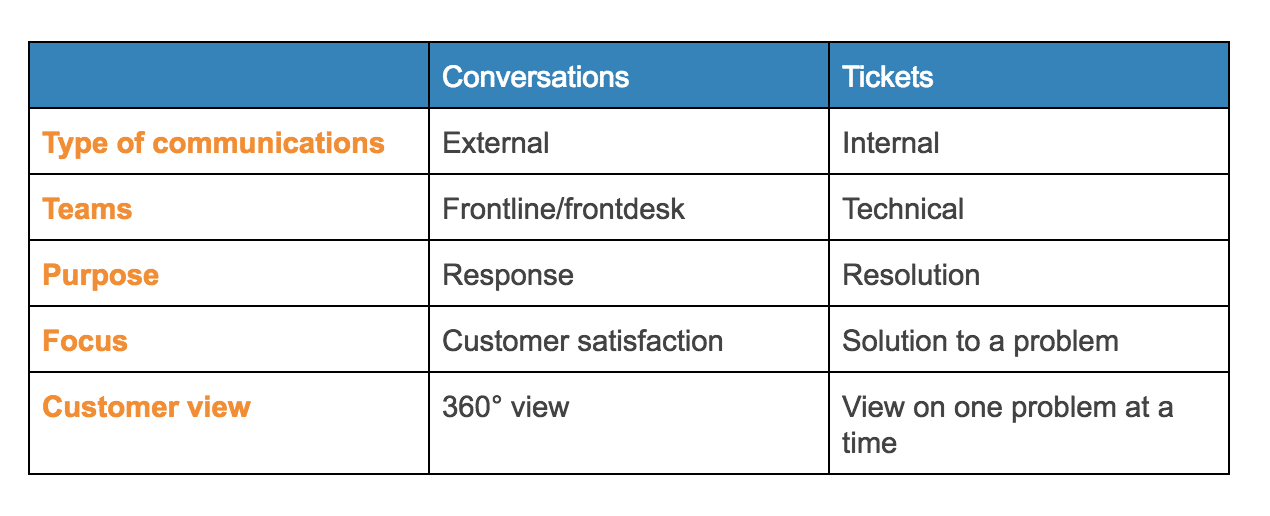.single-post table, .single-post th, .single-post td {
border: 0;
}
Tickets have been used for customer service since the 1990s, and the term remains widely used. However, since that time, the landscape of customer service evolved dramatically. After being limited to phone interactions, it progressively integrated channels used by customers’ in their daily lives: social media, email, messaging…
These changes mean that the way to interact with customers should evolve towards a conversational approach. Customers now expect convenient, quick and personalized interactions with brands. They do not want to fill tickets and depend on companies’ internal processes: 66% of consumers say they’re likely to switch brands if they feel treated like a number, not an individual. However, tickets remain relevant for internal collaboration to solve customer issues.
A good approach is to combine both conversations and tickets for different purposes. We review in this article the differences between both approaches, and how to make the most of their complementarity.
What is a Ticketing System?
The “support ticket” is a term that appeared in the 1990s in the IT services industry. It was first used to fix issues related to products like computers, electronic equipment or software.
The purpose of this system is to centralize the requests and go over a defined process towards the resolution. Thanks to its assignment system, a ticket defines who should do something and answer at each step of the process.
One of the most common ways to start tickets is via email, contact form or live chat. After initiating the conversation, customers usually receive an auto-response with the ticket number and specific elements.
With this way of interacting, a ticket, or case, is opened when a customer sends an enquiry. It is associated with different elements to identify it:
- Ticket number
- Topic
- Person to which it is assigned
- Generic signature
The ticketing system allows to gather all the required information to solve an issue and track the different steps to solve it. The approach of this system is oriented towards the resolution of the problem. Tickets are especially relevant for internal communication when multiples departments need to be involved in a problem resolution.
Customers’ expectations for a seamless experience
The transition to conversations
Whether it is social media, messaging or email, customers are using a variety of channels to engage conversations with brands. 72% of them now expect to reach agents via their channel of choice.
Customers expect seamless and quick interactions, using the same channels as with their peers. One of the major trends illustrating it is the growing use of Messaging, with applications such as WhatsApp Business and Apple Business Chat.
The use of these channels for customer service means that customers do not want to deal with complex processes. Rather than receiving formal auto-responses, they want to feel heard and being informed of the resolution’s step. Even if the company cannot solve the problem right away, customers will be satisfied to have a quick response giving them more information about the resolution.
Moreover, having conversations with customers is an opportunity to better understand them and prevent churn. When customers can ask questions or get assistance through apps they use daily, they will be more likely to contact the brand for any type of problem. This gives companies the opportunity to solve minor problems before it becomes a reason of churn. On the contrary, when customers have to use complex tickets systems, they will be less likely to send an enquiry whenever a problem happens.
This transition to conversations gives customer satisfaction more importance. By being less focused on the fact to close the ticket, agents can reduce reiteration and improve First Contact Resolution (FCR). Improving this KPI has a positive impact on a number of metrics such as CSAT and Employee Satisfaction.
|
|

|
Levi Olmstead
Manager, Community Outreach and SEO at G2 Crowd |
The limits of tickets for Omni-Digital
An omni-digital strategy means that interactions are taking place on a variety of channels. Omni-digital customers frequently use more than one channel for a single issue. In that case, it is easier for the company to get a unified view of all interactions, rather than individual tickets.
Here are some of the main limits of a ticketing system when it comes to managing large volumes of conversations with customers:
- Tickets are not adapted to the channels’ specificities: the ticket format is very different from the ones of conversations. It is formatted with the ticket number, specific boxes where customers have to type, often ending up in very long threads.
- One ticket for one specific issue: each case is linked to a specific issue or question. Once it is solved, the ticket is closed and no conversation history is kept. It means that if the customer still has a problem or another question to ask, he will have to open a new ticket and repeating the same information. It will be the same if the customer does not reply in the timeframe defined by the company before the ticket expires.
- No 360° customer view: agents replying to tickets focus on the issue to solve. The only information they get is the one shared by the customer. Agents don’t access the conversation history or transactional information. This means the interaction will require many back-and-forths to get the right information. It results in a lot of effort and frustration for customers, who may not understand why the company is not able to retrieve their information.
- No queue management system: tickets are usually processed on a first-come, first-served basis. For a company facing large volumes of interactions daily, this approach is problematic. To better optimize the activity, messages should be organized and prioritized according to criteria such as the topic, status of the customer and channel.
|
|

|
Nate Brown
Director, Customer Experience, EHS Sustainability |
How to choose the right approach?
Tickets and conversations are complementary, and most companies use both approaches. Tickets are mostly adapted to the resolution of technical problems and internal collaboration between multiple departments. It allows to categorize the problem and escalate it internally.

Conversations are adapted to digital channels to communicate with customers. It allows to adapt to the specificities of channels, to provide a smooth experience to customers. Beyond the tool used, adopting one approach or the other relates to your global customer experience strategy. When customers reach out to you, do you start a conversation or give them a ticket number? In other words, this aspect reveals whether your company is customer-centric or problem-centric.
Ticket systems evolved, and many of them now adapt interactions from digital channels to the ticketing system, removing the constraints of a traditional system from the customer perspective (ticket number, unfriendly format, etc.). While this is not optimal for large volumes of customer interactions on multiple channels, it can be used in some cases.
Here are some of the criteria to consider to determine which approach to adopt:
- Channels of interaction: Looking at the number and type of digital channels adopted will give you insights in which approach should be favored. For example, a company whose interactions are mostly by phone, with a small share via email, can consider using tickets. On the contrary, a company adopting an omni-digital strategy with multiple channels such as messaging, social media, email and live chat should adopt a tool allowing a conversational approach.
- Volumes of interactions: the volumes of interactions will also influence this choice. If volumes are low, the adoption of tickets can be considered. It is possible to reach a good response time and there are no productivity stakes. But a company having large daily volumes needs a platform centralizing all-digital channels, with the ability to route messages to the right person, prioritize them according to different criteria, and provide a view of past interactions.
- Type of customer enquiries: depending on the type of enquiries, one approach can be chosen rather than another. For example, an IT company implementing channels dedicated to the resolution of customers’ technical problems can choose a ticketing system. If we now take the case of a company whose customer enquiries cover several topics on multiples digital channels, a customer engagement platform is more relevant. Processing large volumes of interactions on an increasing number of channels requires to adopt the right strategy and tools. Companies faced with this challenge and wishing to provide a consistent experience can now rely on an advanced customer engagement platform. By regrouping messages from all digital channels (email, messaging, live-chat, social media, etc.), it creates unified threads across channels. This provides agents a unified view of past conversations, resulting in better customer experience and faster resolution.
Conclusion
Providing seamless and consistent experiences is becoming the norm for customer care. By adopting conversations instead of tickets to interact with customers, you move from a problem-centric approach to a customer-centric one. Instead of having a ticket limited to a specific problem, you access a global customer view, including past interactions from all digital channels. That way, customer satisfaction is prioritized over the company’s internal processes. In addition, tickets should be used for internal collaboration to solve a problem. That way, the best of both approaches is leveraged, contributing to outstanding in-person and e-commerce customer service.
To help you better understand the differences between both approaches, here is a summary of their main characteristics:

Originally published Mar 11, 2019, updated Jul 19, 2021






